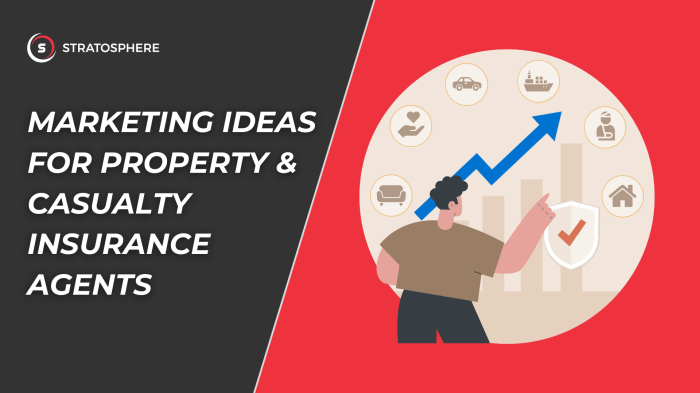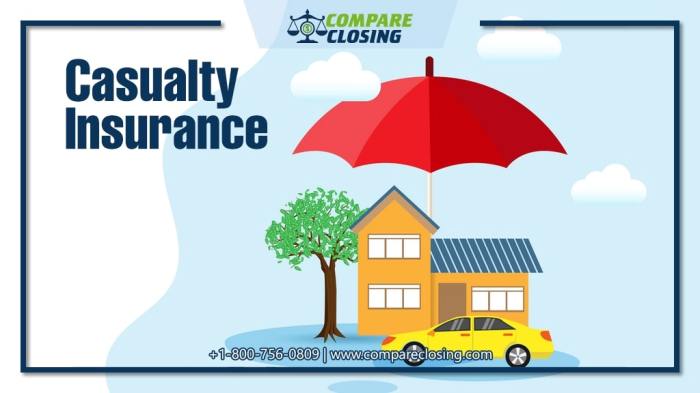In the realm of insurance, property and casualty insurance stands as a crucial shield against unforeseen events that can jeopardize your assets and financial stability. As an insurance professional, your role is not merely to sell policies; it is to guide individuals and businesses in securing their peace of mind.
This comprehensive guide delves into the intricacies of selling property and casualty insurance, empowering you with the knowledge and strategies to excel in this dynamic field.
With a blend of expertise and empathy, you will discover how to effectively communicate the value of insurance coverage, build lasting customer relationships, and navigate objections with confidence. From understanding market trends to leveraging technology, this guide equips you with the tools to succeed in the ever-changing insurance landscape.
Understanding Property and Casualty Insurance

Property and casualty insurance is a type of insurance that protects individuals and businesses from financial losses resulting from damage to or loss of property and from liability for injuries or damages caused to others. This coverage is essential for safeguarding your assets and providing peace of mind in case of unforeseen events.
Common types of property and casualty insurance policies include:
- Homeowners insurance: Protects your home and personal belongings from damage caused by fire, theft, vandalism, and other covered perils.
- Renters insurance: Provides coverage for your personal belongings in a rental property.
- Auto insurance: Covers your vehicle in case of damage or loss due to accidents, theft, or other covered events.
- Business insurance: Protects your business property and assets from various risks, including fire, theft, liability, and business interruption.
It’s crucial to understand the coverage limits and exclusions of your insurance policy. Coverage limits determine the maximum amount the insurance company will pay for a covered loss. Exclusions are specific events or situations that are not covered by the policy.
Researching the Market

Understanding the market landscape is crucial for developing successful property and casualty insurance strategies. This involves identifying key trends, analyzing competitor offerings, and gathering insights from potential customers.
Identify Key Market Trends and Demands
Stay informed about emerging trends and shifts in the property and casualty insurance market. This includes monitoring changes in consumer behavior, regulatory policies, and technological advancements. Understanding these trends allows you to anticipate market demands and tailor your offerings accordingly.
Analyze Competitor Strategies and Offerings
Conduct thorough competitor analysis to gain insights into their strengths, weaknesses, and market positioning. Examine their product offerings, pricing strategies, and marketing campaigns. This analysis helps you identify areas where you can differentiate your offerings and gain a competitive advantage.
Conduct Surveys or Interviews to Gather Insights from Potential Customers
Engage with potential customers through surveys, interviews, or focus groups to gather valuable feedback. Ask questions about their insurance needs, concerns, and preferences. This direct interaction provides insights into customer pain points and unmet needs, enabling you to develop products and services that cater to their specific requirements.
Developing a Strong Sales Pitch

Creating a compelling sales pitch is crucial for effectively communicating the value and benefits of your property and casualty insurance products to potential customers. This pitch should be tailored to address their specific needs and concerns, and delivered with confidence and enthusiasm.
To develop a strong sales pitch, consider the following strategies:
Highlight the Benefits and Value of Your Products
- Emphasize the unique features and advantages of your property and casualty insurance products that set them apart from competitors.
- Explain how your products can provide peace of mind and financial protection to customers in case of unexpected events.
- Use clear and concise language that is easy for customers to understand.
Practice Delivering Your Sales Pitch Effectively
- Practice delivering your sales pitch in front of a mirror or with a colleague to gain confidence and identify areas for improvement.
- Pay attention to your tone of voice, body language, and eye contact to ensure you are communicating effectively.
- Be prepared to answer questions and objections from potential customers.
Incorporate Customer Testimonials or Success Stories
- Share positive customer testimonials or success stories to build trust and credibility with potential customers.
- Highlight how your products have helped customers resolve claims and recover from unexpected events.
- Use testimonials and success stories to demonstrate the real-world value of your products.
Building Customer Relationships
Cultivating strong customer relationships is a cornerstone of success in the property and casualty insurance industry. It entails establishing and nurturing mutually beneficial connections with both potential and existing clients.
Building customer relationships is a crucial aspect of selling property and casualty insurance. By fostering strong connections with customers, insurance agents can increase sales, improve customer retention, and build a loyal customer base.
Personalized Communication
Personalized communication is a powerful tool for building customer relationships. It involves tailoring interactions with customers based on their individual needs, preferences, and circumstances. This can be achieved through various channels, such as phone calls, emails, social media, and in-person meetings.
- Utilize customer data: Gather and analyze customer data to gain insights into their needs, preferences, and behaviors.
- Tailor communication: Customize messages, offers, and recommendations based on the unique characteristics of each customer.
- Engage in active listening: Pay attention to customer concerns and feedback to understand their perspectives and address their needs effectively.
Exceptional Service
Providing exceptional service is a key factor in building strong customer relationships. This involves going above and beyond to meet and exceed customer expectations. It encompasses aspects such as responsiveness, reliability, and professionalism.
- Be responsive: Respond to customer inquiries and requests promptly and efficiently.
- Be reliable: Deliver on your promises and commitments to customers.
- Be professional: Maintain a professional demeanor in all interactions with customers.
Active Listening
Active listening is a critical skill for building customer relationships. It involves paying full attention to what customers are saying, both verbally and nonverbally, and seeking to understand their needs and concerns.
- Give customers your full attention: Make eye contact, lean in, and avoid distractions.
- Ask open-ended questions: Encourage customers to elaborate on their thoughts and feelings.
- Reflect and paraphrase: Restate what you have heard to ensure understanding.
Tailored Solutions
Offering tailored solutions is a key aspect of building customer relationships in property and casualty insurance. This involves understanding each customer’s unique needs and circumstances and developing insurance plans that meet those specific requirements.
- Conduct a thorough needs assessment: Gather information about the customer’s property, assets, and risk tolerance.
- Develop a customized insurance plan: Tailor the coverage and limits to align with the customer’s specific needs.
- Explain the benefits and value of the plan: Help the customer understand how the plan meets their unique requirements.
Ongoing Support
Providing ongoing support is essential for maintaining strong customer relationships. This involves being available to answer questions, address concerns, and provide assistance throughout the life of the insurance policy.
- Be accessible: Make it easy for customers to contact you through multiple channels.
- Respond promptly to inquiries: Address customer questions and concerns in a timely manner.
- Provide proactive support: Reach out to customers regularly to ensure their needs are being met.
Utilizing Technology and Digital Tools
In today’s digital age, leveraging technology and digital tools is crucial for property and casualty insurance sales success. These tools streamline the sales process, enhance customer engagement, and expand market reach.
Digital Platforms and Tools
Implement digital tools and platforms designed specifically for insurance sales. These tools can automate tasks, manage customer data, and provide real-time insights into sales performance. They streamline the sales process, enabling agents to focus on building relationships and closing deals.
Social Media and Online Advertising
Harness the power of social media and online advertising to connect with a wider audience and generate leads. Create engaging content, participate in relevant online communities, and utilize targeted advertising campaigns to reach potential customers. Social media platforms offer a cost-effective way to promote your insurance offerings and establish your brand as a thought leader in the industry.
User-Friendly Website
Develop an informative and user-friendly website that showcases your insurance offerings. Ensure your website is easy to navigate, provides comprehensive information about your products and services, and includes clear calls to action. A well-designed website serves as a valuable resource for potential customers, providing them with the information they need to make informed decisions.
Handling Objections and Concerns

Effectively addressing objections and concerns is crucial in selling property and casualty insurance. Anticipate potential customer apprehensions and develop compelling responses that demonstrate empathy and understanding. Offer alternative solutions to meet customer needs and overcome objections.
Understanding Customer Concerns
Common concerns raised by potential customers may include:
- Cost and Affordability: Customers may express concerns about the cost of insurance premiums and whether they can afford the coverage.
- Coverage and Exclusions: Customers may have questions about the specific coverage provided by the policy and any exclusions or limitations.
- Claims Process: Customers may be concerned about the claims process and whether their claims will be handled promptly and fairly.
- Trust and Reliability: Customers may have concerns about the reputation and reliability of the insurance company.
Effective Responses to Objections
To effectively address customer concerns, consider the following strategies:
- Empathize and Listen: Show empathy and understanding towards the customer’s concerns. Listen actively and acknowledge their apprehensions.
- Provide Clear Explanations: Offer clear and concise explanations about the policy’s coverage, terms, and conditions. Address any misconceptions or misunderstandings.
- Offer Alternatives: If a customer expresses concerns about cost, explore different coverage options or payment plans that may better suit their budget.
- Highlight Benefits: Emphasize the benefits and value of the insurance coverage. Explain how it can provide peace of mind and financial protection.
- Build Trust: Share testimonials or success stories from satisfied customers. Provide information about the insurance company’s history, reputation, and financial stability.
Upselling and Cross-Selling Opportunities

Uncover and capitalize on opportunities to expand your customer base and revenue streams by offering additional insurance products or services that complement their existing policies.
Incentivize customers to purchase multiple products through bundled packages or discounts, creating a win-win situation where they receive comprehensive coverage at a competitive price while you increase your sales.
Continuously Monitor Customer Needs
Stay attuned to your customers’ evolving needs and preferences by regularly conducting surveys, reviewing customer feedback, and analyzing policy usage data. This ongoing monitoring allows you to identify opportunities to offer relevant recommendations that align with their changing circumstances and requirements.
Staying Informed and Adapting to Changes
In the ever-evolving world of property and casualty insurance, staying informed and adapting to changes is crucial for success. By keeping abreast of industry trends, regulatory modifications, and emerging insurance products, you can ensure that your sales strategies remain relevant and effective.
Moreover, continuously refining your sales techniques based on market feedback and changing customer needs is essential for maintaining a competitive edge. Furthermore, embracing innovation and adapting to emerging technologies will enable you to deliver exceptional customer service and stay ahead of the curve.
Continuous Learning and Improvement
To stay informed, consider subscribing to industry publications, attending conferences and webinars, and actively participating in professional organizations. This proactive approach will keep you updated on the latest developments and trends, enabling you to adjust your sales pitch and strategies accordingly.
Market Feedback and Customer Needs
Regularly seek feedback from customers to identify areas for improvement and adapt your sales approach. Conduct surveys, analyze customer data, and engage in conversations to gain insights into their evolving needs and preferences. By incorporating this feedback into your sales strategy, you can enhance the customer experience and increase your chances of closing deals.
Embracing Innovation and Technology
The insurance industry is rapidly embracing technology, and staying up-to-date with these advancements can give you a significant advantage. Explore new technologies such as artificial intelligence, machine learning, and blockchain to streamline your sales process, improve customer engagement, and enhance your overall efficiency.
Measuring and Evaluating Sales Performance

Measuring and evaluating sales performance is crucial for property and casualty insurance agents to track their progress, identify areas for improvement, and make data-driven decisions. By establishing clear goals, monitoring key performance indicators (KPIs), and regularly reviewing sales performance, agents can optimize their strategies and maximize their success.
Establish Clear Sales Goals and Targets
Setting clear sales goals and targets is essential for measuring and evaluating sales performance. These goals should be specific, measurable, achievable, relevant, and time-bound (SMART). They should align with the overall business objectives and take into account market conditions, customer needs, and competitive factors.
Clearly defined goals provide a benchmark against which agents can track their progress and assess their success.
Regularly Review Sales Performance
Regularly reviewing sales performance is key to identifying areas for improvement and making necessary adjustments to sales strategies. Agents should track their progress towards their goals, analyze sales data, and identify trends and patterns. This ongoing review process allows agents to stay informed about their performance, address challenges promptly, and capitalize on opportunities.
Implement a System to Monitor Key Performance Indicators (KPIs)
Implementing a system to monitor key performance indicators (KPIs) enables agents to make data-driven decisions and optimize their sales strategies. Relevant KPIs for property and casualty insurance agents may include sales volume, market share, customer acquisition, customer retention, average policy size, and profitability.
By tracking these KPIs, agents can gain insights into their strengths and weaknesses, adjust their sales approach accordingly, and improve their overall performance.
Continuous Learning and Professional Development

In the dynamic world of property and casualty insurance, continuous learning is essential for staying ahead of the curve and delivering exceptional service to clients. By engaging in ongoing professional development, you can enhance your knowledge, skills, and expertise, ultimately leading to increased sales success.
Attend Industry Conferences, Workshops, and Training Programs
Actively participate in industry conferences, workshops, and training programs to stay informed about the latest trends, regulations, and best practices. These events provide opportunities to network with peers, learn from experts, and gain insights into emerging technologies and market developments.
Seek Feedback from Colleagues, Mentors, and Customers
Solicit feedback from colleagues, mentors, and customers to identify areas for personal and professional growth. Constructive criticism can help you recognize your strengths and weaknesses, allowing you to focus on improving your sales skills and techniques.
Stay Updated with the Latest Insurance Products, Regulations, and Best Practices
Keep yourself updated with the latest insurance products, regulations, and best practices. Stay informed about new coverage options, policy changes, and industry standards to provide accurate and comprehensive advice to your clients.
Last Point

As you embark on your journey as a property and casualty insurance professional, remember that success lies in your ability to protect your clients’ interests, provide exceptional service, and adapt to the evolving needs of the market. Embrace the opportunity to make a genuine difference in people’s lives by safeguarding their financial well-being.
The rewards of this noble profession extend beyond monetary gain; they lie in the satisfaction of knowing you have made a positive impact on the lives of those you serve.
FAQ Summary
Question: What are the key factors to consider when developing a strong sales pitch for property and casualty insurance?
Answer: When crafting a compelling sales pitch, focus on highlighting the benefits and value of your insurance products, emphasizing how they provide peace of mind and financial protection against potential risks. Incorporate customer testimonials or success stories to build trust and demonstrate the tangible benefits of choosing your insurance solutions.
Question: How can I build strong customer relationships in the property and casualty insurance industry?
Answer: Building strong customer relationships is crucial in the insurance industry. Foster personalized communication, actively listen to their needs and concerns, and provide tailored solutions. Offer ongoing support and assistance to maintain customer satisfaction and demonstrate your commitment to their well-being.
Question: How can I utilize technology and digital tools to enhance my sales performance in property and casualty insurance?
Answer: Embrace digital tools and platforms to streamline the sales process and enhance customer engagement. Utilize social media and online advertising to reach a wider audience and generate leads. Create an informative and user-friendly website that showcases your insurance offerings and provides valuable resources to potential customers.



